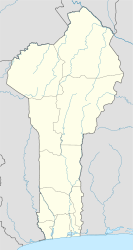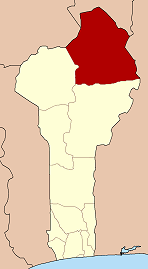Banikoara | |
|---|---|
| Coordinates: 11°18′N 2°26′E / 11.300°N 2.433°E | |
| Country | |
| Department | Alibori Department |
| Area | |
| • Commune, arrondissement and city | 4,383 km2 (1,692 sq mi) |
| Elevation | 300 m (1,000 ft) |
| Population (2013) | |
| • Commune, arrondissement and city | 248,621 |
| • Density | 57/km2 (150/sq mi) |
| • Metro | 28,402 |
| Time zone | UTC+1 (WAT) |
| Postal address | BP: 01 |
| Area code | (+223) 29 |
Banikoara [ba.ni.kwa.ʁa] is a town, arrondissement and commune located in the Alibori Department of Benin. It lies 69 kilometers west of Kandi at the heart of the most productive cotton-growing region in Benin. Its name is a Europeanized version of a Bariba phrase meaning "Bani's town", and honors its founder, Bani Gansé.
Banikoara, like many areas of Benin, is home to a constituent monarchy.[1]
Administrative divisions
[edit]Banikoara is subdivided into 10 arrondissements; Banikoara, Founougo, Gomparou, Goumori, Kokey, Kokiborou, Ounet, Sompérékou, Soroko and Toura. They contain 53 villages and 11 urban districts.[2]
The arrondissement of Banikoara contains the villages of Arbonga, Demanou, Derou Garou, Kokire, Kommon, Kori Ginguiri, Tokey Banta, Wagou, Weterou and Yadikparou.[3]
Demographics
[edit]The commune covers an area of 4383 square kilometres and as of 2002 had a population of 152,028 people.[2][4] In 2008 there was an estimated 24,917 living in the main town.[5]
Economy
[edit]Most of the population are engaged in agricultural activities followed by trade and handicrafts. 51 024,00 hectares of land are devoted to agriculture, accounting for 7.32% of the total land area.[2] The main crops grown are maize, cotton, sorghum and cowpeas.[2]
Electricity used in Banikora often has to be produced by a generator due to a defective solar system and unreliable mains electricity.[6] The telephone lines are in poor condition, which makes it difficult to maintain a regular and reliable connection for Internet access.[6] Banikoara is 60 kilometres from the nearest hard road and its development is hampered by its isolation until infrastructure develops.[6]
Media
[edit]UNESCO has donated four computers and other equipment and provided an initial two-week training and been responsible for the establishment of a radio station in Banikoara in 1994.[6] They had provided education to local people in basic IT and Internet skills since February 2002, text processing, photocopying, scanning, printing and photography.[6]
References
[edit]- ^ "Présidence du Haut conseil des rois du Bénin:Kpodégbé Lanmanfan reconduit pour un nouveau mandat | Benin : Actualité, politique, Sport, Santé, Artetculture". Archived from the original on 2022-01-04.
- ^ a b c d "Banikoara". Atlas Monographique des Communes du Benin. Retrieved January 5, 2010.
- ^ "Point des Realisations par Village" (PDF). Direction Générale de l'Eau du Benin. 24 April 2014. Archived from the original (PDF) on 4 March 2016. Retrieved 28 July 2015.
- ^ "Communes of Benin". Statoids. Archived from the original on 2 January 2010. Retrieved January 5, 2010.
- ^ "Banikoara". World Gazetteer. Archived from the original on February 9, 2013. Retrieved 2008-12-21.
- ^ a b c d e "Benin-Banikoara". UNESCO. Retrieved January 8, 2010.



Well, that’s interesting to know that Psilotum nudum are known as whisk ferns. Psilotum nudum is the commoner species of the two. While the P. flaccidum is a rare species and is found in the tropical islands. Both the species are usually epiphytic in habit and grow upon tree ferns. These species may also be terrestrial and grow in humus or in the crevices of the rocks.
View the detailed Guide of Psilotum nudum: Detailed Study Of Psilotum Nudum (Whisk Fern), Classification, Anatomy, Reproduction